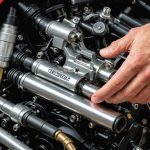Understanding Turbocharger Installation
When considering a turbocharger installation, it’s essential to understand its primary function: enhancing engine performance by increasing airflow. This airflow boost translates into more power generated from the engine. However, successful turbocharger installation hinges on several key components being properly fitted and securely mounted.
Key elements include the turbocharger housing, turbine, and compressor. Each plays a crucial role in delivering power efficiently. The turbine harnesses exhaust gases, while the compressor draws in and compresses air, feeding it into the engine’s intake manifold. This requires careful alignment to ensure optimal performance and avoid mechanical strain.
Also to see : Ultimate diy guide: safely changing and disposing of your car battery in the uk
In the UK, regulations govern the installation of turbochargers to ensure compliance and safety. It’s crucial to adhere to these standards, which might involve specific guidelines on emissions and noise limits. Regulations also cover aspects like roadworthiness and modifications approval, which can differ compared to other regions.
Understanding these compliance requirements is essential for legal and safe operation, safeguarding both vehicle integrity and public safety. Proper installation, combined with regulatory compliance, ensures the turbocharger functions at its best, contributing to enhanced vehicle performance without compromising safety or legal obligations.
Additional reading : Ultimate guide to converting your uk vehicle to hydrogen fuel: essential legal and technical insights
Required Tools and Equipment
When embarking on a turbocharger installation, having the right installation tools and equipment is critical. For instance, a well-prepared equipment checklist will ensure that all necessary tools are on hand, reducing interruptions during the installation process. Essential tools include a torque wrench, socket set, and screwdriver set. These tools are vital for securing components and ensuring optimal fitting techniques.
Additionally, specific equipment like a lift or jack might be recommended for safe handling and assembly, enabling easy access to the engine and ensuring components are mounted securely. Remember, poor alignment can lead to issues, underscoring the significance of precision during installation.
Preparing a maintenance supply kit is also advisable. This kit should include lubricants, sealants, and spare parts, aiding follow-up care and enhancing the turbocharger’s performance. Regular checks and smooth operations post-installation are crucial for longevity, preventing potential future failures.
Ensuring a comprehensive collection of installation tools and an equipment checklist not only facilitates a smoother installation process but also contributes to the turbocharger’s effectiveness and durability. By investing in quality tools and assembling the right maintenance supplies, you can achieve a successful installation and optimal performance.
Step-by-Step Installation Process
Embarking on a turbocharger installation requires adherence to detailed installation guidelines to ensure a robust setup and optimal performance. Begin by thoroughly inspecting the assembly steps provided by your turbocharger manufacturer, as specific requirements may vary.
-
Preparation: Ensure the engine is clean and free from debris. Disconnect the battery and remove any components obstructing access to the turbocharger installation area.
-
Positioning: Align the turbocharger correctly, paying attention to the exhaust manifold and engine intake. Proper alignment is crucial as misalignment can cause strain and reduce efficiency.
-
Secure Fitting: Use appropriate fitting techniques to attach the turbocharger. Ensure all bolts are evenly tightened for secure mounting, preventing potential leaks.
-
Sealing: Apply suitable gaskets and sealants to all joints. This step is essential to avoid exhaust or boost leaks, impacting the turbocharger’s function.
-
Final Inspection: After installation, scrutinize all connections, ensuring there are no loose components. Finally, reconnect all removed parts and double-check alignment.
Incorporating these installation guidelines will facilitate a successful installation, allowing your vehicle to benefit from enhanced performance. Keeping UK-specific regulations in mind during this process ensures legal compliance and safe operation.
Common Pitfalls to Avoid
When undertaking a turbocharger installation, knowing potential installation mistakes is crucial to ensuring success. A frequent error involves improper alignment, leading to increased strain and reduced efficiency. Ensuring that the turbocharger, housing, and other components are correctly aligned prevents this issue. Another common pitfall is neglecting bolt torque specifications, which can result in loose fittings and potential leakage. Using a torque wrench to adhere to manufacturer specifications can mitigate this risk.
Addressing these troubleshooting tips early on is vital. For instance, consistently check for leaking oil or coolant during installation, as these can indicate improper sealing—a simple yet effective preventive measure to avoid costly repairs. Additionally, failing to follow the specified installation guidelines can cause compliance issues with UK regulations, resulting in potential legal and operational consequences.
By learning from user experiences, one can gain practical insights into avoiding these pitfalls. Users often suggest double-checking all connections and employing secure mounting techniques to ensure a robust fit. Proper research and preparation, informed by collective experiences, foster a smoother installation process, aiding in enhancing the turbocharger’s performance and longevity.
Safety Precautions
When executing a turbocharger installation, prioritising installation safety is paramount. Adequate preparation, including organising your workspace and ensuring proper ventilation, contributes significantly to a safe installation environment. Proper layout minimises the risk of accidents while increasing efficiency during the installation.
Wearing suitable safety gear is critical. Essential items include safety glasses, gloves, and hard-wearing clothing. These elements protect against potential hazards such as debris or hot surfaces. Always follow the necessary precautions when working with heavy machinery or parts.
In the event of an unforeseen incident, knowing the correct emergency procedures is crucial. Creating a clear action plan, including having a fire extinguisher accessible and a first aid kit on hand, can substantially mitigate risks. Moreover, always have a mobile phone or other communication devices within reach to call for help if needed.
By adhering to these safety-oriented practices, one can effectively avoid mishaps, ensuring a smooth turbocharger installation. These precautions not only promote a legally compliant and secure installation but also safeguard the longevity and performance of your turbocharger. Always stay informed and prepared for all eventualities.
Maintenance Tips Post-Installation
Ensuring your turbocharger operates at peak efficiency doesn’t stop once it’s installed. Routine turbocharger maintenance is crucial for maintaining performance and extending the lifespan of this critical engine component.
Firstly, regular performance checks should be conducted to monitor the turbocharger’s effectiveness and detect any potential issues early. Key performance indicators include monitoring boost pressure, checking for unusual noises, and ensuring there are no leaks in the system.
To enhance longevity, focus on techniques such as consistently using high-quality oil and maintaining proper oil levels. Dirty or low-quality oil can lead to increased wear and tear, reducing turbocharger lifespan. Thus, timely oil changes are essential.
If you encounter any problems post-installation, troubleshooting common issues becomes necessary. For instance, if you notice decreased power or odd noises, check for loose fittings or leaks. Addressing these promptly can prevent further complications.
Additionally, periodically inspecting all connections and fittings ensures that the turbocharger remains securely mounted. By following these maintenance tips, you can enjoy improved vehicle performance and durability, safeguarding your investment in the long run. Remember, proactive care is key to a well-functioning turbocharger.
Professional Help and Resources
Deciding whether to pursue a professional installation for your turbocharger is a crucial choice. While DIY installations can be rewarding, the precision required means professional assistance might be a safer option. Experts offer comprehensive service recommendations, ensuring the turbocharger is securely mounted and functions optimally.
If considering professional services, opt for reputable garages or technicians with verifiable experience in turbocharger installations. In the UK, choosing specialists familiar with UK-specific regulations can avert potential legal inconveniences. Recommendations often point towards garages certified by recognised automotive bodies, providing peace of mind that your investment is in safe hands.
For those who prefer a hands-on approach but require additional guidance, reliable resources are available online. Various guides provide step-by-step instructions tailored for different vehicle models. These resources cover everything from the initial stages of selecting the appropriate installation tools to advanced troubleshooting techniques for any unforeseen issues.
By weighing the benefits of professional versus personal involvement, and utilising reliable resources, you can make informed decisions. This approach not only ensures your vehicle’s peak performance but also extends the lifespan of your turbocharger, aligning with your automotive aspirations.











